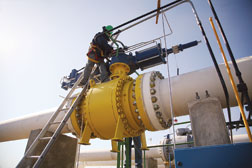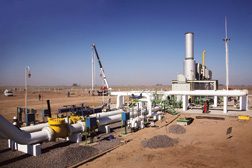Argentina is the second-largest country in South America and its sheer size is one of the greatest obstacles it faces concerning its energy supply. The reserves of natural gas that it relies upon for power must travel from the farthest reaches of its borders and even a bit beyond. To forestall an energy shortage that would jeopardize ongoing efforts to right the country’s shaky economy, Argentina is pushing a massive program to construct 2,300 kilometers of new pipeline that will increase the country’s natural-gas capacity by 22 million cubic meters per day.
 C.J. Schexnayder |
 C.J. Schexnayder Buffeted by Antarctic winds, workers in southern Argentina must deal with deep cold that stops work for part of the year.
|
The Argentinean arm of Brazilian construction giant Odebrecht is heading an $1.9-billion effort to construct almost three-fourths of that line, almost 1,700 kilometers, by the first quarter of 2010. In addition, nine compressor plants will be retrofitted and six new ones built.
“The short time frame is a major challenge,” says Odebrecht construction manager Arlindo Facadio. “It’s a logistically difficult job to do, and flexibility is the key to making it possible.”
So far, the firm’s efforts have been successful. Almost 45% of the work has been completed, and the job remains on budget and on schedule.
With the third-largest proven reserves of natural gas in South America, behind Venezuela and Bolivia, the country depends heavily on the resource for its massive energy needs. As much as 59% of Argentina’s primary energy consumption is derived from natural gas, most of that focused in the industrial heart of the country near the capital, Buenos Aires. That’s a problem since the major Argentinean gas fields are in the southern reaches, as far as distant Tierra del Fuego and across the tempestuous Straits of Magellan. Its northern neighbor, Bolivia, provides abundant supply as well.
The result is a natural gas pipeline infrastructure that spans nearly the entire 3,650-km length of the country. In the area north of the capital, the lines leading from Bolivia are under the control of private firm Transportadora de Gas del Norte (TGN). South of Buenos Aires, pipelines stretching to the tip of the continent are operated by Transportadora de Gas del Sur (TGS), a subsidiary of the private-sector firm Ciesa, whose main shareholder is Petrobras, Brazil’s giant state oil company.
|
Odebrecht’s portion of the effort to build the new line entails construction of 67 pipeline segments called loops that run alongside the existing line built more than a decade ago. The new segments, which range from five to 72 kilometers in length, will dramatically amplify the volume of gas conveyed along the line, Facadio says.
“Basically, we are installing a second line parallel to the trunk line in segments,” he says. “You have the capability of connecting all the loops at some point in the future to create an entirely separate line as well.”
The specific length and number of the loops have been established by a mathematical model developed by TGN and TGS that defines specific areas along the pipeline that need additional capacity and additional pressure.
“The mathematical model identifies where the bottlenecks are and, using that, they have determined the points where the new loops and plants are needed to increase capacity but maintain a balance between the pipeline and the level of pressure,” he says.
In all, the company will install 657 km of pipeline in the southern portion of the route and 968 km in the north. The internal diameter of the steel pipeline is mostly 30 in., with a pipe thickness varying between 8.14 mm and 11.9 mm, depending on location. Each section length is 12 meters and is connected to the adjacent sections using a straight weld.
The entire line is underground, with construction handled with standard equipment including side booms, excavators and cranes. Some specialized equipment for tasks such as horizontal directional drilling was used for several river crossings, including one that is a full kilometer in length.
| + click to enlarge | + click to enlarge |
 |  |
| Argentina's Natural Gas Trunk Link. | |
The effort to construct the new line and why it is so critical to Argentina’s future goes back over a decade. In the late 1990s Argentina’s economy faltered badly, leading to a massive $98-billion debt default in 2001.
The financial turmoil forced the government to curtail spending, including a range of big-ticket infrastructure projects. As a result, plans to upgrade the pipeline were shelved, which put a strain on energy demands and the lagging infrastructure to meet them. Moreover, one of the measures enacted to stop the economic collapse was a freeze on privatized utilities’ tariffs, which had the effect of bringing all of Argentina’s infrastructure efforts to a complete halt.
By 2002 the nation’s finances recovered significantly, and the economy began racking up annual growth rates in excess of 8%. Yet the lack of transmission and distribution infrastructure as well as the now-artificially low prices led to power shortages in 2004.
While stopgap efforts have covered the shortfall, increasing demands on the energy infrastructure threaten a severe economic crisis as power prices skyrocket due to limited availability.
 C.J. Schexnayder Compressor stations speed natural gas on its way to cities and industry.
|
To counter that grim scenario, the Argentinean government unveiled the 2006-2008 Firm Gas Transportation Capacity Expansion Project with the goal of bolstering the country’s natural-gas transportation and supply capacity to 145 million cu m per day.
Odebrecht’s involvement came about partly due to timing and shrewd business strategy. In 2005, ENARGAS, the national gas regulation agency, held an open bid for businesses interested in additional firm capacity of gas transportation. Two companies responded: Cammesa, a private-sector company with government ties to regulating production of electric power in Argentina; and Albanesi, a private firm that handles energy production and natural-gas sales.
“Since it was an open bid the information was public,” says Facadio. “We approached those two...
 Related Links:
Related Links: 
Post a comment to this article
Report Abusive Comment